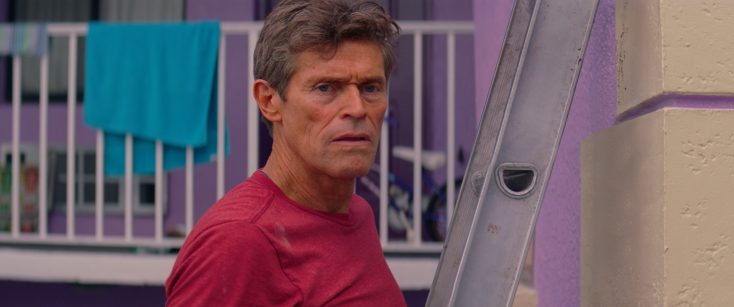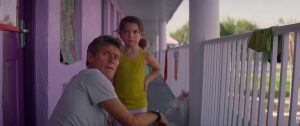By ANGELA DAWSON
Front Row Features
HOLLYWOOD— Willem Dafoe arrives for an interview fortified by a cup of black coffee. The two-time Oscar nominee (“Platoon,” “Shadow of the Vampire”) reveals he returned to the U.S. from Australia just two days earlier after a five-month shoot on the latest effects-laden DC Comics superhero movie “Aquaman,” in which he plays Nuidis Vulko, who—at least in the comic book canon—is an adviser to the titular hero, played in the film by Jason Momoa. Not surprisingly, Dafoe is hesitant to reveal much about the film or his character, other than to say that he spent a lot of time Down Under on Warner Bros. sound stages hoisted on wires to simulate movement of the water-bound character.
Dafoe stars in a small, independent film called “The Florida Project,” about people living in the not-so-magical outskirts that surround Orlando’s Disney World. Written and directed by Sean Baker, co-creator of the TV comedy series “Greg the Bunny” and critically acclaimed 2015 indie dramedy “Tangerine,” about a transgender prostitute, “The Florida Project” centers on a marginalized group of transients living in a no-star motel, just a stone’s throw—yet a world away—from the Happiest Place on Earth.
Dafoe plays the short-term inn’s multi-tasking manager, Bobby, who spends his long days not only trying to stay one step ahead of the aging facility’s infrastructure, but also administering to the needs of its down-on-their-luck occupants. One such family is a young mother and daughter who live in one of the rooms that were never designed as permanent homes. Six-year-old Moonie (played by precocious seven-year old Brooklynn Kimberly Prince) spends her summer days not at the Magic Kingdom, which might as well be on another planet, but hanging out with other local urchins who come from fractured or unstable homes. While better-off kids are soaking up “It’s a Small World” and other rides at the iconic amusement park, Moonie and her fellow pint-size pals find their entertainment in spitting on guests’ cars from the motel’s balcony, panhandling for ice cream, yelling expletives at unsuspecting sunbathers and engaging in dangerous, destructive behavior. Her young, tattooed mom, Hailey (newcomer Bria Vinaite) does whatever she can to make the $35-a-night rent. Bobby, meanwhile, does what he can to protect these fragile people while trying to keep their only refuge in compliance with the law.
Though familiar with the Orlando area, where some of his family live, Dafoe says he wasn’t aware of this subsector of society that has grown in recent years, owing to the economic downturn and societal changes. Working with Baker and tackling the role of the hardworking maintenance man trying to do good in a messed-up world was a big draw for him in taking on the role.
Q: Were you as harried by these kids as the character and the adults making it?
Dafoe: There were parallels, let’s just put it that way. It was fun to make. It was a beautiful script. Sean (Baker, the director) is very good at rolling with things, particularly with the children he had to sometimes create situations so they didn’t have to actually play a scene and they could put things in their own words. He’d find parallel things that would accomplish what he needed to accomplish in the scene.
Every day was interesting. Every day was a challenge. It’s true. I love those kids but sometimes they were a real pain. That just made my job easier because there was so much reality in where we were shooting, with whom we were shooting and what we were doing. It was interesting.
Q: How were they a pain?
Dafoe: In order to let them feel free and not feel self-conscious about acting, Sean really encouraged them to have fun and be a little devilish. They’d get cranked up the way kids do. Plus, they had all the attention of the film crew, sort of a built-in audience. They’re parents were there but they were kind of letting them do their thing so they got revved up, as kids do. So, sometimes you’d be playing a scene and they didn’t want to be playing it, then you have to bring them back.
Q: The credits acknowledge the film’s links to “The Little Rascals.” Moonie is the ringleader, like Spanky in that old series from several decades ago?
Dafoe: Yeah, and (“The Little Rascals”) was set during the Depression. The adults around them, although they weren’t really featured, they weren’t going through easy times. The kids were kind of similar—they were grifters. They were scheming. They were causing trouble. They were mischievous. Sean never mentioned the connection during the shoot but then when I heard him say it when we started doing press, it made all the sense in the world.
Q: Did you have a backstory for your character?
Dafoe: I had something of a backstory. In doing research, I talked to some people who have this job and have this life. That was helpful, not just to get the psychology of where they come from but to get the little details, like what kind of watch they’re wearing, whether they wear any jewelry, how they cut their hair, how they present themselves and how they carry themselves. One of the biggest things that I took away from that is that he’s very proud of his job and he is very proud that he made the motel a better place than it was. That was kind of nice. I didn’t recognize it when I was doing the movie but, in retrospect, when I see the movie, when I see Bobby, he’s not an extraordinary person in the sense of talent or ambition. He’s a quite simple, normal guy. He’s like the average guy who tries to make the world a better place. His world is this little community. It has resonance because we all have that in our lives. We know our limitations but we also try to apply ourselves because we feel best when we try to make things better.
Q: Since you were the most experienced actor in this, did you serve as kind of a mentor to the other actors?
Dafoe: I didn’t need to. My job was to fit in with them because they were very well cast. Sean is very shrewd in knowing how to make them feel comfortable. Sometimes, a non-acting approach to acting is more effective. So, I tried to be of that world. That’s true anyway. Sometimes movies require performances that are in your face, very bold and kind of show-offy. Others, it depends on what your job is; what your function is within the construct of the movie. In others, you really want to disappear. You almost hope the audience doesn’t know you’re an actor. I’ve been doing this long enough that it’s likely that (an audience) has seen me in another movie—I don’t fool them completely—but the idea is nice. The idea of being in that community and not having there be a difference, I liked it.
Even in a studio movie, sometimes you have a wide-range of skill because actors come from a wide-range of places. Some are highly trained with lots of experience and some just have that “thing.” You always have to be in the world with these other people so it wasn’t as extreme as you might think.
Q: Speaking of big, studio movies, what’s happening with “Aquaman?”
Dafoe: I finished two days ago. I just came from Australia after five months of shooting, and they’re still going because it’s a very effects-heavy movie because so much of (takes place) underwater. Particularly the Atlantean creatures, of which I am one of, we don’t walk around. We swim. And when we’re standing, we’re not standing terra firma, we’re floating. You can imagine what that requires. It requires a lot of wire work and different devices, so we’re floating and when it’s time to (exit a scene), you turn and swim away, and those things will be sweetened (in post-production) and the wires will be erased but, basically, you have to get the basic movement. That’s a huge part of the scene. So, it’s quite intensive.
Q: Did you have to do a lot of research for your “Aquaman” role? Did you read 20 years’ worth of comics?
Dafoe: I’d like to talk about “The Florida Project,” because there will be plenty of time later to talk about “Aquaman.”
Q: Had you worked or spent much time in Florida before making this film?
Dafoe: I have family in Orlando. I’m from Wisconsin but (my family) were snowbirds. My parents retired down there. They’re both dead but two of my sisters now live there. So, I know that area very well.
Q: So, did you spend much time there yourself?
Dafoe: Yeah. My father died when he was 97 but he retired there when he was 65, so he lived there 30 years. I’d go there to visit my parents and my sisters. When my son was small, I’d go there with him to see the grandparents and, of course, I’d take him to Disney World. Of course, I wasn’t familiar with (the motel featured in the film) The Magic Castle. So, I did know this area quite well. In fact, to get the accent for Bobby, which is very slight and there are all kinds of accents in Florida but I wanted to play with something, I taped my brother-in-law who was reluctant to curse. Because he’s religious. But he did it for me. As it turned out, I didn’t end up using his accent because it didn’t sound right. You know, the title (of the movie) comes from the code name they used for Disney World when they were planning it.
Q: What’s next for you?
Dafoe: I go off to France to work with (director) Julian Schnabel for a film called “At Eternity’s Gate.” It’s not a biopic but I play Vincent van Gogh. Hence, I’m starting to grow my beard. I don’t have a beard in “Aquaman” so I just started. We shoot in Aurel (in Southern France) and Paris.
Q: You worked with Wes Anderson on “The Life Aquatic with Steve Zissou.” Are you going to work again with him?
Dafoe: I hope so. I saw him this summer. And, I would say, yes. Nothing concrete but he’s working on something and I saw all the index cards out there because he’s planning out scenes so teased him. I said, “Wes, am I in there somewhere?” and he said, “You’re in there.” So, that’s good.






